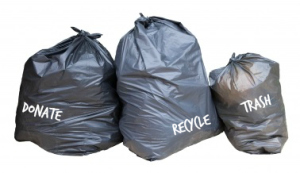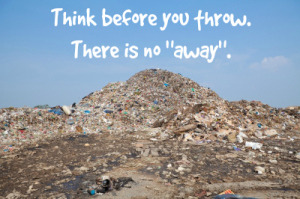We’re on to part 3 of our series already – first we looked at life with “stuff”, then we spoke about how to weed out some of the clutter, and now that you have decided what you no longer want to keep, the next step is to get it out of your house – but many people are not sure where or how to do this. We want to avoid sending items to landfill as far as possible, but what are the other options?
# 1 – DON’T Just chuck it: Only a very small percentage of stuff we want to get rid of should end up in landfill. With just a little bit of thought and preparation you should be able to find many more productive and responsible ways to move it on. Remember…
# 2 – DO Sell it: This is often the preferred way to get rid of stuff as you know it’s going to someone who wants it, plus you can recoup some of the money you spent on the item in the first place. There are a range of online options like eBay, Gumtree, and Fishpond (who will even come and collect your old books, CDs and DVDs from your house and list them for you!), local Buy / Swap / Sell groups on Facebook, plus more traditional options like garage sales and second hand goods markets.
# 3 – DO Donate it: If you do not have the time to list all your items online or stand at a market stall, the next best thing is to donate them. There are so many wonderful charities who can put your items to much better use. A few of my local favourites are:
- For women’s work clothes – Fitted For Work (fittedforwork.org) help disadvantaged women gain employment
- For baby and preschool items – St Kilda Mums (stkildamums.org) support families suffering hardship, locally and abroad
- For books – The Footpath Library (footpathlibrary.org)
- For old towels and linen – animal shelters
- For old reading glasses – many libraries recycle these for elderly people who cannot afford new glasses
- For just about anything – Freecycle (freecycle.org) is like eBay for free stuff
# 4 – DO Recycle it: If your items are not in good enough condition to be sold or donated, then recycling is the next best option. Almost everything can be recycled so don’t just throw it away! You just need to do a little research to find out where to take specific items. For example – stores like Ikea and Bunnings have recycling bins for batteries and light bulbs, and Officeworks stores have recycling bins for ink and toner cartridges and mobile phones. Also check with your local council as many of them have recycling programs for these items too, plus old paint and other household chemicals. For information on recycling various electronic goods, check out www.ewaste.com.au – these items are very dangerous in landfill and contain many re-usable components, so are ideal for recycling.
# 5 – DO Repurpose it: If you are gifted with crafty genes then this is a fantastic way to bring new life to old items. Have a look on Pinterest and you will find hundreds of clever ideas on turning bicycle parts into gates, plastic bottles into lamp shades, broken crockery into jewellery, old ladders into shelves, empty toilet rolls into hair tie holders, etc. It can certainly be a lot of fun and provide a great conversation piece in your home!
The trick, with the 4 ‘do’ options, is to actually do it! Remember from last month – “Clutter exists due to lack of decisive action” so make decisions and then take the required action, otherwise the clutter will continue. When donating to charities, always check beforehand what they can and can’t accept. Also feel free to contact me if you would like help finding your local organisations.
Next month we will be looking at some storage dos and don’ts, and how to make the most of the storage space you have available. Until next time…
Beverley
Originally posted 2014-11-12 22:31:12.


